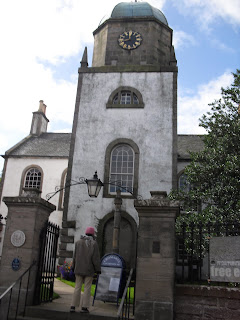This post is in two parts: the first covers the tiny Highland hamlets of Ledgowan and Achnasheen, which we visited on our way to Skye; the second covers our day trip around the Black Isle, which is actually a peninsula just northeast of Inverness.
Ledgowan and Achnasheen
Our first stop on the Skye day trip was here, in the aptly-named Field of Storms (Gaelic: achnasheen), at the foot of one of the few passes over the spine of the Highlands south of the northern coast and north of Loch Ness.
View Larger Map
The prevailing westerly winds howl down through said pass and over Achnasheen fast enough to make a grown man unsteady on his feet. Hence all those trees you see aren't just for decoration: they're there to make it possible to hear yourself think on the way from your door to your car.
Now, having, like most American young men, seen Braveheart about a billion times, I was interested to see how different the Scottish Highlands look from how they're depicted in the film. The Highlands are not actually green--they just filmed mostly in the green bits, and in Ireland.
No, in reality, the highlands are brown and purple (yes, purple, thanks to the heather).
The Highlands (or at least the parts that are actually high) are also remarkably barren, something more like what you'd expect from the American West. There's simply a lot more space than you'd expect to find anywhere in such a small country.
It's worth noting, however, that the Highlands aren't quite a wilderness, in that the Highlands as they are today are largely man-made: the slopes above used to be covered about halfway up with forests of Scots pine, but the earliest settlers (we're talking prehistoric here) clear-cut the place even before Scotland passed into the historical record.
In many of the more sheltered glens, there has been an effort to replant, both for environmental and commercial reasons, but the Field of Storms is largely out of luck thanks to the wind.
The Black Isle
The Black Isle isn't an island: it's actually a peninsula between the Cromarty Firth and the Moray Firth, just north of Inverness. No one is sure how it got its name--some say it was a late stronghold of witchcraft, some say the forests along its coasts made it look black--but my money's on the place being named after the extremely dark, extremely fertile soil, which made the Black Isle one of the breadbaskets of the Highlands.
We toured the Black Isle for a morning in the open top of a double-decker bus, which was terrible for the body temperature, but absolutely perfect for grooving to the Highland tunes they piped in on our audio tour headsets.
Wait, is that . . . ? Yes, it is! The Schecky dance (sp?) in the Highlands!
Our first stop of the morning was at the ruined priory of Beauly (from the French beau lieu), established by Norman monks around 1230.
Beauly Priory is built of the same Old Red Sandstone prominent throughout the Eastern half of the highlands, giving it a distinctly pink hue.
From Beauly, we continued on to Cromarty, an old fishing village at the tip of the Black Isle, where the Cromarty Firth branches off from the Moray Firth. In the background of the picture below are the Sutors of Cromarty, two high bluffs marking the entrance to the Cromarty Firth. Today, the Firth is actually used to store and repair North Sea oil rigs; the narrows by the Sutors keep the waters of the Firth calm year-round.

Cromarty spent most of its history as a royal burgh, which means it had a measure of urban independence from the feudal system, and that it was a designated port for overseas trade, mostly with France and the Low Countries. Unfortunately for her, Nana found all this history altogether too exciting, and had to be chained up in the refurbished jail for creating a public disturbance.
Our final stop of the morning was at Chanonry Point, on the southern coast of the Black Isle. The Moray Firth is home to a large colony of bottlenose dolphins, and the crisscrossing currents between Chanonry Point and Fort George are the colony's favorite feeding grounds. It's supposed to be one of the best spots for viewing wild dolphins in the whole of Europe, and given the show they put on for us, I can't disagree!
The little buggers are pretty hard to photograph, though, so you'll have to take my word for it. We did get to see them up close--no more than fifty yards away--and we even caught a glimpse of one of the local seals.
Chanonry Point is also the site of a very pretty--and still privately owned and operated--lighthouse, which you can see below.

A final word about the Black Isle: it's also home to one of Scotland's foremost microbreweries, the Black Isle Brewery, which produces a line of very tasty organic beers.











Mmmm... breadbasket of the highlands...
ReplyDeleteJackie